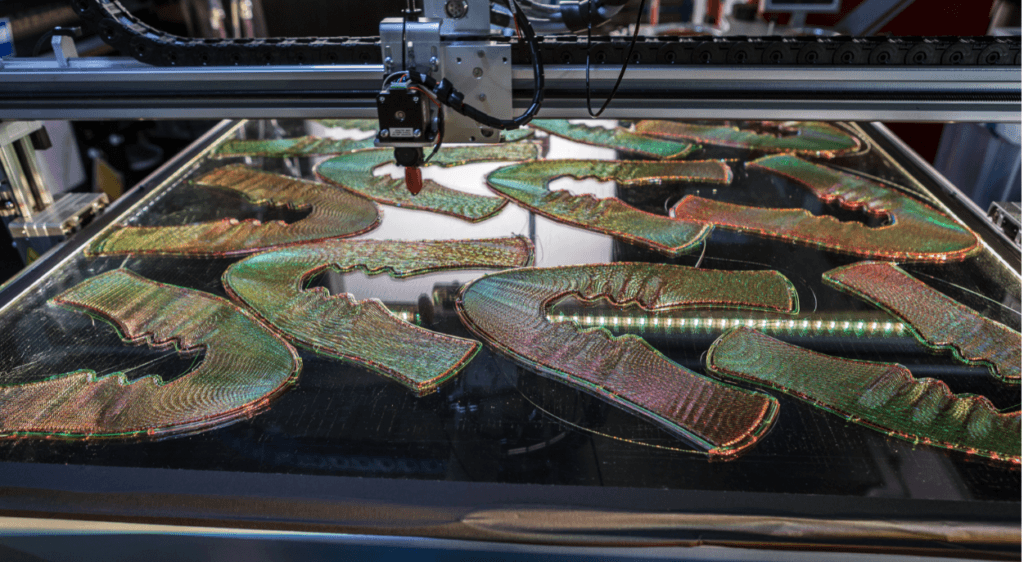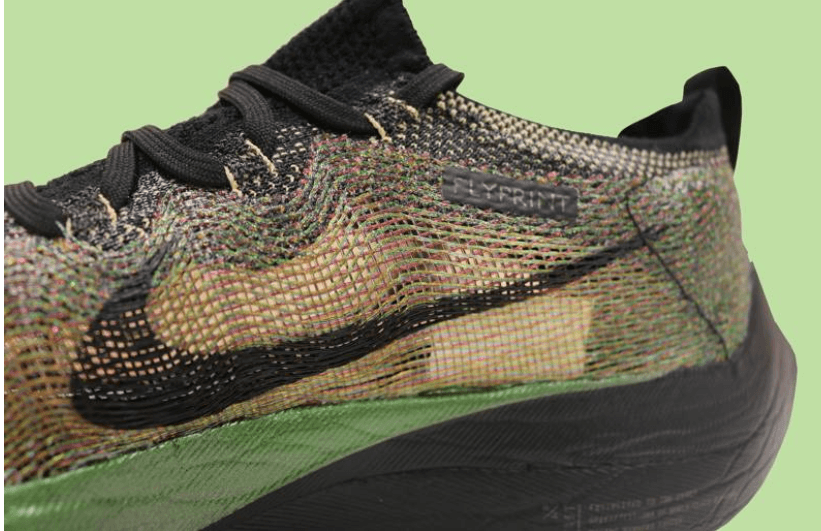Nike’s 3D Printing: Just Do It
One of the world's leaders in sport innovation reveals their latest additions to 3D printing
3D printing is critical in helping Nike achieve their three milestones; “2X Innovation, 2X Speed and 2X Direct” [1]. Additive manufacturing is well-known for transforming traditional manufacturing, for example through providing the ability to quickly print spare parts on demand within the auto [2] and aerospace [3] industries. Nike is using this technology to bring more customized, lightweight, precise and innovative products to the market, at a fraction of the speed of older methods. I shall go through each of these individual process and product improvements to portray the vast importance of 3D printing for Nike.
Nike’s first 3D printed shoe, a football cleat, hit the market in 2013. 3D printing enabled Nike to test and revise the prototype many times in the cycle, but at a much faster rate to previously; updates were provided to the shoe in a matter of hours not months[4]. In April 2018, Nike released their latest 3D printed shoe, Nike Flyprint, which can be prototyped 16 times faster than previous methods[5]. 3D printing can enable design tweaking to occur locally whilst the broader construction path keeps going, meaning the testing and revision cycle time is significantly reduced.
Nike’s inspiration for innovation comes through working with world-class athletes to create the perfect shoe. Nike noticed Eliud Kipchoge’s struggle during the rainy 2017 Berlin marathon and partnered with him to print an upper (part of the shoe that covers the foot) which was waterproof. Nike produced a waterproof and lightweight (11g lighter than his original pair [6]) shoe by replacing yarn (used in traditional manufacturing) with plastic. They were also able to tweak and customize the shoe simultaneously because Nike could use 3D printing to isolate individual strands that needed changing without altering the whole shoe. 3D printing enabled Nike to create shapes not possible with traditional manufacturing processes[7]. With his lighter, more flexible and highly customized shoe, Eliud Kipchoge went on to win the London 2018 marathon.
 Figure 1: Finished Nike Flyprint uppers ready for removal from the printer. Nike News
Figure 1: Finished Nike Flyprint uppers ready for removal from the printer. Nike News
“By fueling massive leaps in our design, prototyping, and manufacturing process, we’re delivering the future of sport, faster.[8]” Management are investing in research and development of additive manufacturing for a limited number of famous athletes (e.g. Michael Johnson) in the short and medium term. Apparel is hugely important for Nike and the team are also investing time into use cases for 3D printing outside of shoes. For instance, in 2014 Nike released a 3D printed sports bag and shin guard for Neymar Jr., Wayne Rooney and Cristiano Ronaldo. Any research in additive manufacturing for Nike’s figureheads in the short and medium term are an opportunity in the longer term to create products for general public.
In the medium to long term Nike should aim to scale this technology through increasing the number of athlete partnerships as well as seeking out technical partners where need be. In 2016 Nike partnered with HP in order to increase prototyping speed given HP’s faster technology. This partnership enabled them to attract Eliud Kipchoge. Nike needs figure heads to spread desire to consumers to reach scale in the longer term. The ultimate goal of Nike should be to enable mass market consumers to obtain a pair of customized, performance enhancing 3D printed shoes. COO Eric Sprunk stated that he envisions a world whereby a consumer buys a digital file from Nike and prints the sneaker at home[9]. In order to achieve this monumental change in consumer shoe purchasing, Nike’s continued investments in the technology and potential partnerships are critical.
We are told that “3D printing simply works best in areas where customization is key”[10]. Nike have done well to showcase this through their partnerships with key athletes, however when thinking about the future we must ask ourselves; how can Nike maintain their advantage over other brands who are also doing additive manufacturing, such as Adidas, through using 3D printing to provide customized shoes? Secondly, what other products can Nike innovate with 3D printing and how could this improve their traditional manufacturing processes?
Figure 2: Prototyping. Nike’s Fly Print trainers initially were developed using all diamond lattices. However, to increase flexibility, waves were built into the threads [11]
[782 Words]
[1] Mark Parker, Nike 2017 letter to shareholders. https://s1.q4cdn.com/806093406/files/doc_financials/2017/ar/mark_parker_letter.html
[2]Alan S Brown, Chain Reaction, Why additive manufacturing is about to transform the supply chain
[3] Dennis Spaeth, 3D Printing is Changing the Face of Multiple Industries
[4] https://news.nike.com/news/nike-debuts-first-ever-football-cleat-built-using-3d-printing-technology
[5] https://news.nike.com/news/nike-flyprint-3d-printed-textile
[6] https://news.nike.com/news/nike-flyprint-3d-printed-textile
[7] Shane Kohatsu, Nike Director of Footwear Innovation, Nike 2017 Annual Report
[8] Mark Parker, Nike 2017 letter to shareholders. https://s1.q4cdn.com/806093406/files/doc_financials/2017/ar/mark_parker_letter.html
[9] https://www.ibtimes.co.uk/nike-trainers-will-be-3d-printed-home-by-consumers-future-1522960
[10] M. Holwef. “The limits of 3D printing.” Harvard Business Review Digital Articles (June 23, 2015).




Great work, Alex — really enjoyed reading your post on Nike! As Nike transitions from creating custom footwear for celebrity athletes to creating similar products for the recreational consumer, it will be interesting to see how they can speed up the fitting/customization process to make it truly scalable.
Awesome post! Nike is one of the great examples where 3D printing is providing current benefits to customers. One concern I have is that Nike’s ambitions seem to be kept at bay by the speed of the technology innovation. You mentioned that they have increased speed through partnerships. Do you think Nike should take it a step further and develop this capability in house. While it may same radical, if it’s paramount for the future of their business (sending customers files instead of shoes), perhaps it makes sense to invest now.
Very interesting Alex! It makes me wonder how can Nike increase the speed with which they take this technology to the customer. As you mention, we are still some time away from being able to print our boots at home. But how far away are we from being able to do it in the store? The fit of your football boot is key when it comes to performance on the pitch, so this would probably be very appreciated by consumers, who could have something made specially for them, instead of using standardized sizes.
Interesting post – particularly in light of today’s case on Nike!
Has Nike provided any information on the cost of 3D-printed products and whether the technology will be higher-margin over the long term? A huge benefit of 3D printing in the aerospace and medical device industries is the cost savings that result by reducing the amount of wasted material – which can be substantial when small parts and components are welded and cast from large pieces of metal using subtractive processes. Intuitively, I wouldn’t expect the same benefit to exist for Nike. Additionally, how does the quality compare to that of traditional processes? Is the quality high enough for 3D-printed products to be used by world-class athletes, in addition to the casual consumer?
A crucial point to keep their advantage versus competitors is the quality and design of the product. They will need to work hard to prove the quality of 3D print products is as high as or/ higher than the quality of normal product and of the competitor’s products. Besides of that, I guess it will be more and more about the external value that comes in addition to the product, so the convenience to print, the service and all the intangible connections with customers (website, events, emotion, inspiration). One question that I have about 3D is on the trilability. I understand you need to be 100% sure you want the product before printing it and that you can only try it after you’ve done this, so I guess this is a space for opportunity and those who dominate that space with have an advantage.
This is great! I could definitely see printing shoes live in a Nike store becoming a hit product. No more massive stock of various sizes and colors, instead just raw materials at the store level that can be used across the product line. Not sure I ever see this transitioning to the house level though, not sure it’s really required when someone can simply have a centralized large scale printer capable of producing huge swathes of products.
It’s interesting how new technologies are only able to maintain their age during a short period of time given that incumbent competitors are able to replicate technologies relatively fast thereby reducing the original edge. With that said, the process of additive manufacturing, while increasing in adoption, it is still relatively new. The next phase of additive manufacturing will likely be driven in the type of material that is used. Additive manufacturing for different materials requires different technologies. In other words, additive manufacturing for metal is very different than plastic. Apparel companies will therefore be able to use materials as a new competitive edge in a world where additive manufacturing itself becomes more common place.